Buzzing Ball of Cactus Bees Wins Wildlife Photographer of the Year
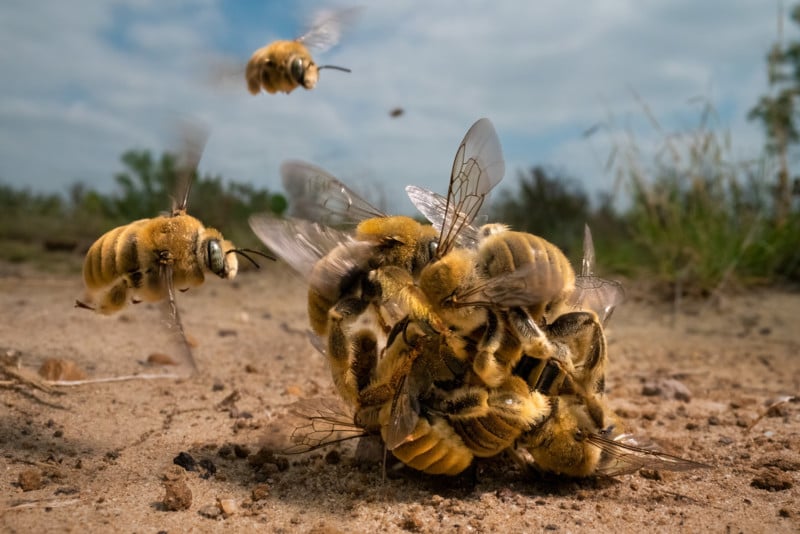
The winners of the Natural History Museum’s Wildlife Photographer of the Year competition have been announced, with American photographer Karine Aigner nabbing the Grand Title award for a photo of a ball of cactus bees.
Wildlife Photographer of the Year is developed and produced by the Natural History Museum in London and was founded in 1965 by BBC Wildlife Magazine, then called Animals. The Natural History Museum joined forces in 1984 to create the competition as it is known today and it is now run and owned by the Natural History Museum, London.
The competition awards two Grand Title awards: Wildlife Photographer of the Year and Young Wildlife Photographer of the Year. The two winning images are selected from 19 category winners that this year included 38,575 entries from 93 countries. The photos were judged anonymously by the Natural History Museum’s panel of experts based on an image’s originality, narrative, technical excellence, and ethical practice.
In August, the organization shared the year’s most commended photos, but have now named the final winning images and the photographers that captured them.
Karine Aigner, the Wildlife Photographer of the Year, is the fifth woman in the competition’s 58-year history to earn the Grand Title Award. Her photo above, titled “The big buzz” which also won the category Behavior: Invertebrates, shows a remarkably close-up view of a ball of cactus bees. All except one are males and they are intent on mating with the single female at the center of the huddle. Like most bees, cactus bees are threatened by habitat loss, pesticides, and climate change, as well as farming practices that disrupt their nesting grounds.
Karine Aigner gets close to the action as a group of bees compete to mate.
Using a macro lens, Karine captured the flurry of activity as a buzzing ball of cactus bees spun over the hot sand. After a few minutes, the pair at its centre – a male clinging to the only female in the scrum – flew away to mate.
The world’s bees are under threat from habitat loss, pesticides and climate change. With 70% of bee species nesting underground, it is increasingly important that areas of natural soil are left undisturbed.
The Young Wildlife Photographer of the Year title was granted to 16-year-old Katanyou Wuttichaitanakorn from Thailand for his photo titled “The beauty of baleen” below, which depicts a Bryde’s whale as it surfaced close to his boat. The photo was the winner of the 15-17 Years old category as well.
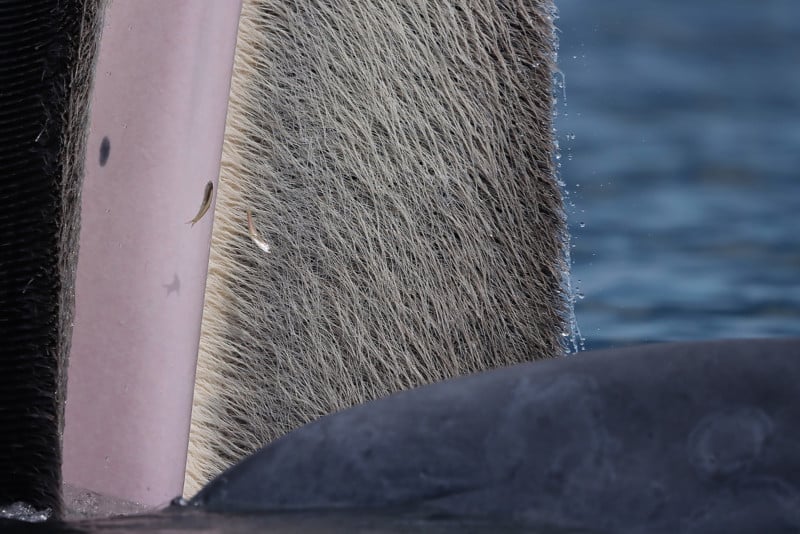
Katanyou Wuttichaitanakorn is intrigued by the contrasting colors and textures of a Bryde’s whale, which surfaces close by.
Following government tourism guidelines, the tour boat Katanyou was traveling on turned off its engine as the whale appeared close by. This meant that Katanyou had to steady his hands to capture this close-up composition as the boat rocked in the swell.
Bryde’s whales have up to 370 pairs of grey-colored plates of baleen growing inside their upper jaws. The plates are made of keratin, a protein that also forms human hair and nails, and are used to filter small prey from the ocean.
Below are the other winning images across the remaining categories with descriptions courtesy of Wildlife Photographer of the Year competition. These photos as well as the winners of the Photojournalist Story Award, Rising Star Portfolio Award, and Portfolio Award can be pursued on the Natural History Museum’s Wildlife Photographer of the Year competition’s website.
10 Years and Under
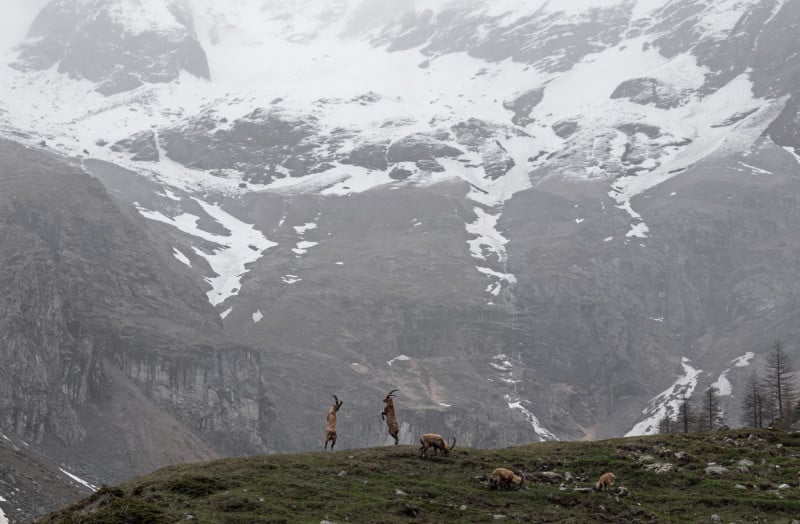
Ekaterina Bee watches as two Alpine ibex spar for supremacy.
It was near the end of a spring day trip with her family that Ekaterina spotted the fight. The two ibex clashed horns and continued to trade blows while standing on their hind legs like boxers in a ring.
In the early 1800s, following centuries of hunting, fewer than 100 Alpine ibex survived in the mountains on the Italy–France border. Successful conservation measures mean that, today, there are more than 50,000.
11-14 Years

Ismael Domínguez Gutiérrez reveals a monochromatic scene as an osprey sits on a dead tree, waiting for the fog to lift.
When Ismael arrived at the wetland, he was disappointed not to be able to see beyond a few metres – and certainly he had no hope of glimpsing the grebes he wanted to photograph. But as the fog began to lift, it revealed the opportunity for this striking composition.
Ospreys are winter visitors to the province of Andalucía. Here the many reservoirs offer these widespread fish‑eating raptors shallow, open water that is clearer than many rivers and lakes.
Animals in their Environment

Daniel Mideros takes a poignant portrait of a disappearing habitat and its inhabitant.
Daniel set up camera traps along a wildlife corridor used to reach high-altitude plateaus. He positioned the cameras to show the disappearing natural landscape with the bear framed at the heart of the image.
These bears, found from western Venezuela to Bolivia, have suffered massive declines as the result of habitat fragmentation and loss. Around the world, as humans continue to build and farm, space for wildlife is increasingly squeezed out.
Animal Portraits

José Juan Hernández Martinez witnesses the dizzying courtship display of a Canary Islands houbara.
José arrived at the houbara’s courtship site at night. By the light of the moon, he dug himself a low hide. From this vantage point he caught the bird’s full puffed-out profile as it took a brief rest from its frenzied performance.
A Canary Islands houbara male returns annually to its courtship site to perform impressive displays. Raising the plumes from the front of its neck and throwing its head back, it will race forward before circling back, resting just seconds before starting again.
Behavior: Birds
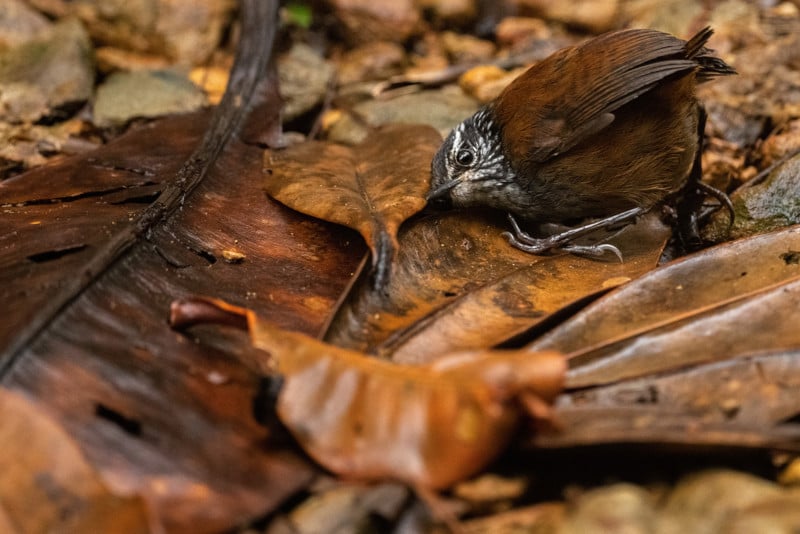
Nick Kanakis gains a glimpse into the secret life of wrens.
Nick spotted the young grey-breasted wood wren foraging. Knowing it would disappear into the forest if approached, he found a clear patch of leaf litter and waited. Sure enough, the little bird hopped into the frame, pressing its ear to the ground to listen for small insects.
This prey-detecting technique is used by other birds, including the Eurasian blackbird. Grey-breasted wood wrens are ground-dwelling birds, often heard but not seen. They broadcast loud, melodious songs and rasping calls while hidden in the undergrowth.
Behavior: Mammals

Anand Nambiar captures an unusual perspective of a snow leopard charging a herd of Himalayan ibex towards a steep edge.
From a vantage point across the ravine, Anand watched the snow leopard manoeuvre uphill from the herd. It was perfectly suited for the environment – unlike Anand, who followed a fitness regime in preparation for the high altitude and cold temperatures.
Snow leopards live in some of the most extreme habitats in the world. They are now classed as vulnerable. Threats include climate change, mining, and hunting of both the snow leopards and their prey.
Behavior: Amphibians and Reptiles

Fernando Constantino Martínez Belmar waits in darkness as a Yucatan rat snake snaps up a bat.
Using a red light to which both bats and snakes are less sensitive, Fernando kept an eye on this Yucatan rat snake poking out of a crack. He had just seconds to get the shot as the rat snake retreated into its crevice with its bat prey.
Every evening at sundown in the Cave of the Hanging Snakes, thousands of bats leave for the night’s feeding. It is also when hungry rat snakes emerge, dangling from the roof to snatch their prey in mid-air.
Natural Artistry

Junji Takasago powers through altitude sickness to produce a dream-like scene.
Junji crept towards the preening group of Chilean flamingos. Framing their choreography within the reflected clouds, he fought back his altitude sickness to capture this dream-like scene.
High in the Andes, Salar de Uyuni is the world’s largest salt pan. It is also one of Bolivia’s largest lithium mines, which threatens the future of these flamingos. Lithium is used in batteries for phones and laptops. Together we can help decrease demand by recycling old electronics.
Oceans: The Bigger Picture

Richard Robinson captures a hopeful moment for a population of whales that has survived against all odds.
Hindered by poor visibility, Richard used a polecam to photograph the whales gradually moving towards his boat. Pushing his camera to its limits in the dark water, he was relieved to find the image pin-sharp and the moment of copulation crystallised in time.
When ready to mate, the female southern right whale rolls onto its back, requiring the male to reach its penis across the female’s body. Known by the Māori as tohorā, the New Zealand population was hunted to near extinction in the 1800s, so every new calf offers new hope.
Plants and Fungi
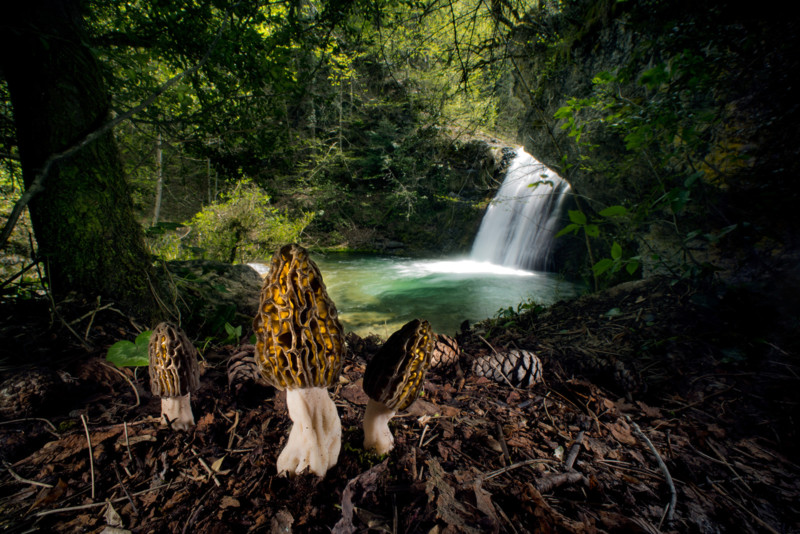
Agorastos Papatsanis composes a fairy tale scene in the forests of Mount Olympus.
Enjoying the interplay between fungi and fairy tales, Agorastos wanted to create a magical scene. He waited for the sun to filter through the trees and light the water in the background, then used a wide-angle lens and flashes to highlight the morels’ labyrinthine forms.
Morels are regarded as gastronomic treasures in many parts of the world because they are difficult to cultivate, yet in some forests they flourish naturally.
Underwater

Tony Wu watches the electrifying reproductive dance of a giant sea star.
As the surrounding water filled with sperm and eggs from spawning sea stars, Tony faced several challenges. Stuck in a small, enclosed bay with only a macro lens for photographing small subjects, he backed up to squeeze the undulating sea star into his field of view, in this galaxy-like scene.
The ‘dancing’ posture of spawning sea stars rising and swaying may help release eggs and sperm, or may help sweep the eggs and sperm into the currents where they fertilise together in the water.
Urban Wildlife

Dmitry Kokh presents this haunting scene of polar bears shrouded in fog at the long-deserted settlement on Kolyuchin.
On a yacht, seeking shelter from a storm, Dmitry spotted the polar bears roaming among the buildings of the long-deserted settlement. As they explored every window and door, Dmitry used a low-noise drone to take a picture that conjures up a post-apocalyptic future.
In the Chukchi Sea region, the normally solitary bears usually migrate further north in the summer, following the retreating sea ice they depend on for hunting seals, their main food. If loose pack ice stays near the coast of this rocky island, bears sometimes investigate.
Wetlands – The Bigger Picture

Daniel Núñez uses a drone to capture the contrast between the forest and the algal growth on Lake Amatitlán.
Daniel took this photograph to raise awareness of the impact of contamination on Lake Amatitlán, which takes in around 75,000 tonnes of waste from Guatemala City every year. ‘It was a sunny day with perfect conditions,’ he says, ‘but it is a sad and shocking moment.’
Cyanobacteria flourishes in the presence of pollutants such as sewage and agricultural fertilisers forming algal blooms. Efforts to restore the Amatitlán wetland are underway but have been hampered by a lack of funding and allegations of political corruption.
Photojournalism

Brent Stirton shares the closing chapter of the story of a much-loved mountain gorilla.
Brent photographed Ndakasi’s rescue as a two-month-old after her troop was brutally killed by a powerful charcoal mafia as a threat to park rangers. Here he memorialised her passing as she lay in the arms of her rescuer and caregiver of 13 years, ranger Andre Bauma.
As a result of unrelenting conservation efforts focusing on the daily protection of individual gorillas, mountain gorilla numbers have quadrupled to over 1,000 in the last 40 years.
Channel 4 News produced the below short documentary video about the competition with the note that this year, more than ever, the images reflect not just the aesthetic glory of their subjects, but the precariousness of their futures too. It includes interviews with some of the yaer’s entrants who also gave the network a preview of their work.
Image Credits: All photos are individually credited and provided courtesy of the Wildlife Photographer of the Year, which is developed and produced by the Natural History Museum, London.